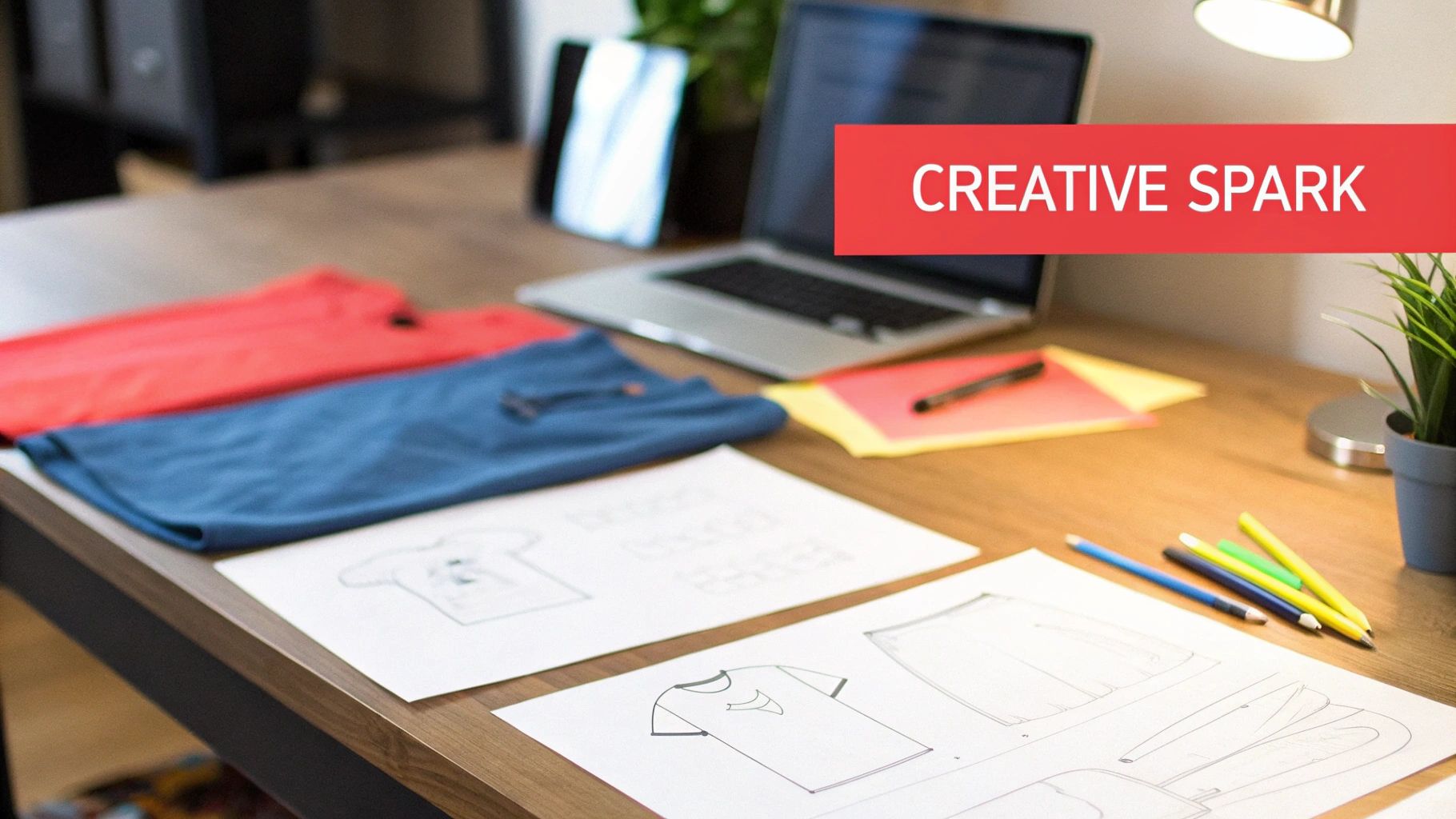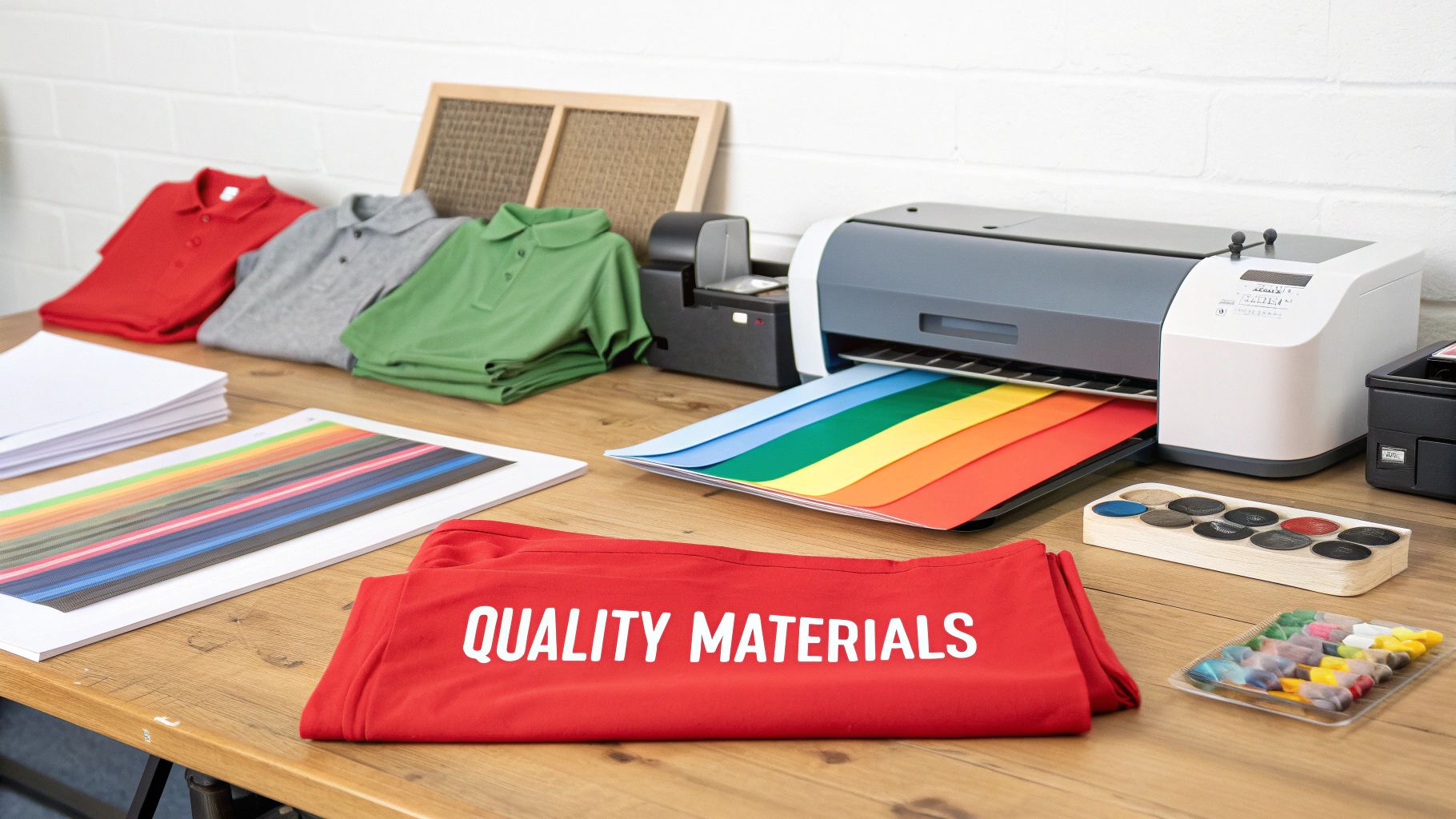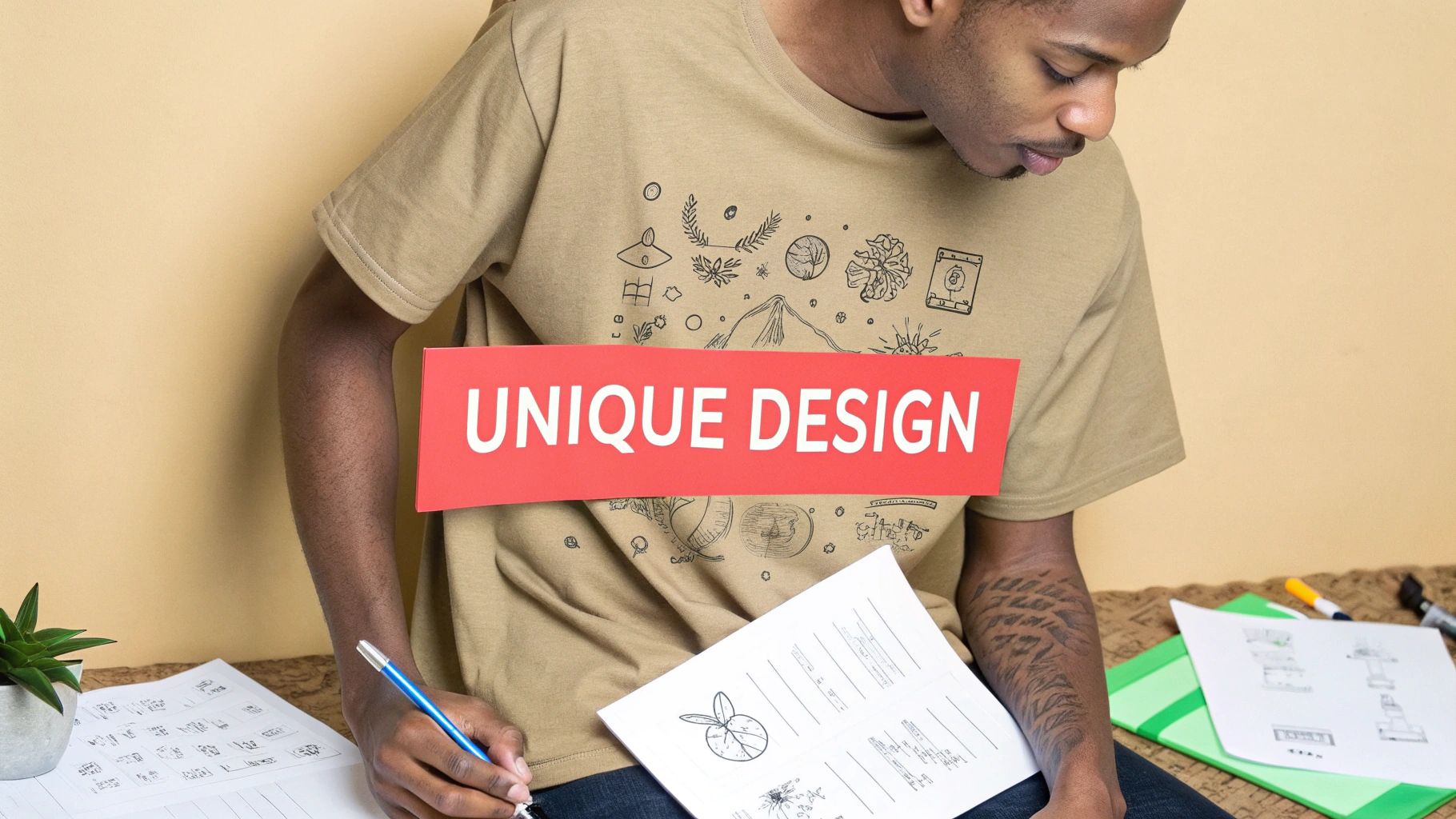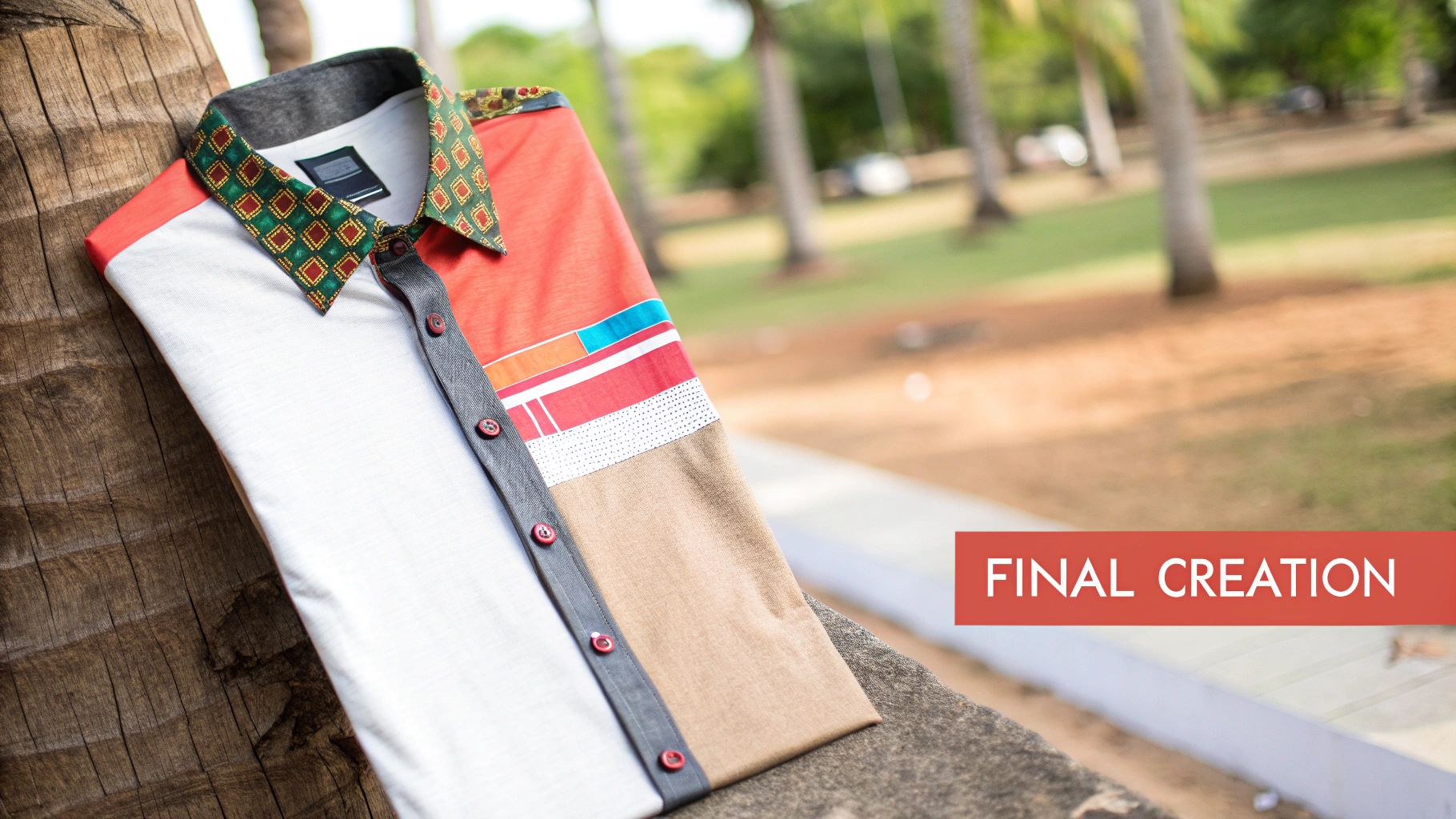Why Design Your Own Shirt? The Psychology of Personal Expression
Designing your own shirt is more than just a pastime; it's a powerful form of self-expression. In a world filled with mass-produced clothing, a personalized shirt offers a unique alternative. It allows you to stand out, showcasing your passions, beliefs, and individuality. This growing trend of self-expression through clothing is changing the fashion world, driven by a basic human need to be unique.
The Rise of Self-Authorship in Fashion
Social media has played a key role in this shift, turning personal style into a public statement. Our clothing choices, once private, are now shared and celebrated online. This encourages us to carefully craft our image and express ourselves through fashion. Designing a shirt becomes an act of self-authorship, allowing you to create your own story and share it with everyone. This resonates particularly with creators, giving them a sense of ownership and control over their personal brand. This movement poses significant challenges to traditional fashion businesses, pushing them to adapt to the increasing demand for unique, personalized designs.
The Power of Personalization
The demand for unique, self-expressive designs isn't just a feeling; it's reflected in real market data. The global custom t-shirt printing market is experiencing significant growth. Valued at $5.16 billion in 2024, the market is projected to grow at a CAGR of 11.5% through 2030. The U.S. market alone, reaching $857.5 million in 2023, is expected to grow by 11.8% annually until 2030. This growth is driven by consumers looking for personalized apparel and businesses using custom shirts for branding, demonstrating a clear shift in consumer behavior. For more statistics, visit: Learn more about the custom t-shirt printing market. This data highlights the increasing importance of personalized apparel in today's world.
Beyond Fashion: A Canvas for Creativity
Designing your own shirt is about more than just wearing clothes; it's about creating a physical representation of who you are. A witty slogan, a favorite band logo, or an original artwork can be a conversation starter and a reflection of your personality. The process itself is also rewarding, allowing you to explore your creativity, experiment with ideas, and experience the joy of bringing your vision to life.

From Concept to Wearable Art
Designing your own shirt empowers you to transform a simple garment into a unique piece of wearable art. It’s a journey from initial concept to final creation, where your ideas take shape and become a tangible expression of your individuality. This process is deeply fulfilling, providing a sense of accomplishment that goes beyond the finished product. It's about taking control of your personal style and making a statement in a world that often pressures us to conform. That's why designing your own shirt has become such a powerful force in today’s fashion.
Essential Tools for Bringing Your Shirt Design to Life
Designing your own shirt is an exciting journey. But before you dive into your creative process, it's essential to have the right tools. This section explores the key digital and physical resources you'll need, from design software to fabric choices, offering insights from experienced custom apparel creators. We'll guide you through the options and help you build a sustainable creation process that fits your budget.
Digital Design Essentials
Your shirt design begins in the digital world. Professional design software like Adobe Photoshop and Adobe Illustrator offer powerful features. However, there are more budget-friendly options available. Free online tools like Canva provide user-friendly interfaces and pre-made templates, making them perfect for beginners. For those interested in diving deeper, check out this resource on mastering design software: How to master using design software. Another great option is Inkscape, a free and open-source vector graphics editor that provides robust features without the hefty price tag.
- Software Options: Adobe Photoshop/Illustrator, Canva, Inkscape, GIMP
- Key Features: Layering, text tools, color palettes, image import/export
Choosing the Right Fabric: A Crucial Decision
The fabric you choose significantly impacts the final product. Different materials hold ink differently, affecting both the vibrancy of your print and its durability. 100% cotton, for instance, offers excellent print quality and breathability. However, it's prone to wrinkling. A cotton-polyester blend provides wrinkle resistance and durability, while performance fabrics are ideal for athletic wear. Consider the shirt's purpose and your desired look when making your selection.
To help you choose the right fabric, we've put together a comparison table outlining the pros and cons of different materials and their compatibility with various printing methods.
To help you navigate the fabric selection process, we’ve compiled a comparison table highlighting key characteristics of different materials.
Shirt Material Comparison for Custom Designs
| Material | Best For | Durability | Print Vibrancy | Cost | Recommended Printing Methods |
|---|---|---|---|---|---|
| 100% Cotton | Comfort, breathability | Moderate | Excellent | Low-Medium | Direct-to-garment (DTG), Screen printing, Heat transfer |
| Cotton-Polyester Blend | Durability, wrinkle resistance | High | Good | Low-Medium | DTG, Screen printing, Heat transfer |
| Polyester (Performance) | Athletic wear, moisture-wicking | High | Good | Medium-High | Sublimation, Heat transfer |
| Tri-blend (Cotton/Polyester/Rayon) | Softness, drape | Moderate | Good | Medium | DTG, Screen printing |
This table provides a starting point for your fabric selection. Choosing the right material will ensure your design looks its best and lasts.
Mastering the Physical Toolkit
With your design finalized, you’ll need the right physical tools to bring your shirt to life. A quality printer, whether inkjet or laser, is essential for transferring your design. Selecting the right transfer paper for your chosen printing method and fabric is also crucial. A heat press offers the most consistent, professional-quality results. However, a standard iron can also be used.
- Essential Equipment: Printer (Inkjet or Laser), Transfer paper, Heat press/Iron
- Optional Equipment: Cutting machine (Cricut/Silhouette), Embellishments (Rhinestones, studs)
Building a Sustainable Creation Process
Designing your own shirts can be a rewarding hobby or a successful business. To maintain momentum, establish a streamlined creation process. This involves organizing your digital files, creating a dedicated workspace, and understanding your budget. Investing in high-quality transfer paper, for example, might seem like an added expense upfront. However, it can significantly improve the longevity of your designs, ultimately saving you money in the long run. Remember, every design is a learning opportunity. Embrace experimentation and continuously refine your techniques.

From Concept to Creation: Design Your Own Shirt Masterclass
Designing your own shirt is a rewarding experience, transforming inspiration into wearable art. This masterclass guides you through the entire process, from initial idea to a finished design ready for ThisShirtExists.com. We'll explore how successful apparel designers combine artistic expression with practicality, offering a step-by-step approach for creating shirts that truly stand out.
Developing Your Concept: From Spark to Sketch
Every great design begins with an idea. Whether it’s a witty saying, a striking visual, or an abstract pattern, your initial concept is the foundation. Start by sketching your ideas on paper. This lets you freely explore compositions and experiment with different elements before going digital. Brainstorm multiple variations, playing with layouts and styles. This initial exploration is crucial for developing a strong, unique design.
The Psychology of Color and Typography
Color is key for conveying the right message and evoking specific emotions. Using bold colors can create energy and excitement, while muted tones offer a more subtle, sophisticated appearance. Consider your target audience and the desired mood when choosing your color palette. Typography is equally important. The font you select significantly impacts your design's overall aesthetic. Experiment with different font styles, sizes, and pairings to find the perfect combination that complements your artwork. A bold sans-serif font, for example, might suit a modern, minimalist design, while a script font can add a touch of elegance.
Composition and Visual Impact: Arranging Your Elements
With your individual elements in place, think about how they interact. Balance is vital, ensuring no single element overpowers the others. Visual hierarchy guides the viewer's eye, creating a clear focal point. A larger central image, for instance, with supporting text placed strategically around it can create a balanced and visually appealing composition. Adapting your design to different shirt colors and styles is also crucial. A design that looks great on a white tee might not work as well on a darker fabric. Test your design on various backgrounds to ensure it remains visually appealing.
Overcoming Creative Blocks and Refining Your Design
The design process isn't always straightforward. Creative blocks happen. Stepping away, seeking inspiration from other artists, or discussing your ideas with friends can help you overcome these hurdles. As your design develops, remember that refinement is essential. Don't hesitate to make adjustments, tweaking elements and experimenting until you achieve the desired result. This iterative process is essential for a polished, professional design. The global custom t-shirt printing market is booming, projected to reach $8.74 billion by 2032, driven by the increasing demand for personalized apparel. This growth is fueled by advancements like Direct-to-Garment (DTG) printing, allowing for easy creation of high-quality custom shirts. Find more detailed statistics here. This demonstrates the widespread appeal and growing accessibility of designing your own shirt.
From Digital Design to Physical Product: Preparing for Print
With your design finalized, prepare it for printing on ThisShirtExists.com. Ensure your design is in a high-resolution format (300 DPI) for a crisp, clear print. The platform offers various shirt styles and colors, allowing you to bring your vision to life. Designing your own shirt lets you express your creativity and wear your unique style with pride.

Selecting Your Perfect Printing Method: Honest Comparisons

After perfecting your design, choosing the right printing method is crucial. This choice significantly impacts the final product's look, feel, and how long it lasts. Each technique has its own pros and cons, so understanding which one best suits your design and goals is essential. This section provides a clear comparison of popular printing methods, using insights from both professional printers and those who enjoy DIY projects.
Screen Printing: The Classic Choice
Screen printing is a tried-and-true method that pushes ink through a mesh screen onto the fabric. This technique creates bold, vibrant designs, particularly on lighter shirts. It’s known for its durability and cost-effectiveness, especially for large orders, which is why it's the industry standard for merchandise and branded clothing. However, screen printing can be less practical for intricate designs or smaller quantities due to the setup involved for each color.
- Pros: Durable, Vibrant colors, Cost-effective for large runs
- Cons: Limited detail, Less suitable for small batches, Complex setup
Heat Transfer: Simplicity and Versatility
Heat transfer printing uses heat and pressure to transfer a design from special paper onto fabric. This method is very versatile, handling many different designs, from photos to complex graphics. It’s also a popular choice for DIY projects because it's relatively inexpensive to start and easy to use. However, heat-transferred designs can sometimes feel stiff and might not be as durable, especially after repeated washing.
- Pros: Versatile design options, Easy to use, Low startup cost
- Cons: Can feel stiff, Less durable than other methods
Direct-to-Garment (DTG) Printing: The Digital Revolution
DTG printing works similarly to a regular inkjet printer, spraying ink directly onto the fabric. This digital process creates highly detailed, full-color prints, making it perfect for complex designs and photographs. DTG is also a great choice for smaller orders and personalized items where screen printing isn't cost-effective. It works best on lighter-colored fabrics. You might be interested in: Our sitemap for more content related to design. Also, the price per shirt can be higher than other methods, especially for larger quantities.
- Pros: Highly detailed prints, Ideal for small orders, Full-color capabilities
- Cons: Best on light fabrics, Higher cost per shirt for large runs
Sublimation Printing: All-Over Vibrant Designs
Sublimation printing uses heat to transfer dye onto polyester fabrics. The ink turns into a gas and bonds with the fibers, creating a bright, all-over print that won't crack or peel. This method is great for bold, eye-catching designs, especially those covering the entire garment. This makes it a good fit for activewear and items needing a seamless design. Sublimation, however, only works on polyester and can be pricier than other options.
- Pros: Vibrant, all-over prints, Durable, Ideal for polyester fabrics
- Cons: Limited to polyester fabrics, Can be expensive
Choosing the Right Method for Your Design
The best printing method depends entirely on your project. Think about things like how complex your design is, the fabric type, your budget, and how many shirts you need. For small batches and intricate designs, DTG printing is often the best choice. For larger orders with simpler designs, screen printing is still a cost-effective solution. The Asia Pacific custom t-shirt market is experiencing significant growth, projected to reach $7.42 billion by 2034 with an 11.41% CAGR. This highlights the growing demand for personalized apparel. Explore this topic further. Understanding each method’s strengths and weaknesses helps bring your design to life exactly as you imagined.
To help you choose, let's look at a detailed comparison:
To help you make the best decision, here's a comparison of the different printing methods:
Comparing Custom Shirt Printing Methods
| Printing Method | Best For | Cost | Durability | Complexity | Production Time | Ideal Batch Size |
|---|---|---|---|---|---|---|
| Screen Printing | Large batches, simple designs | Low per unit for large runs | High | Low | Longer setup, fast printing | High |
| Heat Transfer | DIY projects, versatile designs | Low startup cost | Moderate | Moderate | Fast | Low to Medium |
| DTG | Small batches, complex designs, photos | Higher per unit | Moderate | High | Fast | Low to Medium |
| Sublimation | All-over prints, polyester fabrics | Moderate to High | High | Moderate | Moderate | Low to High |
This table summarizes the key differences between each method, making it easier to select the best fit for your custom shirt project. Consider your design's complexity and your budget when making your decision.
Digital Platforms That Truly Deliver Custom Shirt Excellence
Designing your own shirt is a rewarding creative experience. But transforming a digital design into a physical product requires the right platform. This section explores online custom shirt services, focusing on those that truly deliver. Through research and user feedback, we'll examine the quality, user experience, and overall value of popular platforms like Printful, Custom Ink, Printify, and other emerging specialists.
Printful: Print-on-Demand Powerhouse
Printful, a leading print-on-demand platform, offers a seamless experience for creating and selling custom merchandise, including shirts. Their extensive product catalog and user-friendly design tools make bringing your designs to life straightforward. Printful also integrates with various e-commerce platforms, simplifying order fulfillment.
- Key Features: Wide product selection, Easy-to-use design tools, E-commerce integrations, No upfront costs
Custom Ink: Group Ordering Made Easy
Custom Ink specializes in group orders, making it a great choice for team shirts, event merchandise, and company apparel. Their collaborative design tools simplify gathering input and approvals from multiple people. This collaborative approach ensures everyone has a voice in the final product.
- Key Features: Collaborative design tools, Group discounts, Dedicated customer support, Wide range of apparel options
Printify: Connecting You With Print Providers
Printify connects you with a network of print providers, offering access to diverse printing methods and product options. You can compare pricing and turnaround times, choosing the best provider for your specific project. Printify also integrates with popular e-commerce platforms. Selecting the right platform is crucial for the success of your design project.
- Key Features: Network of print providers, Wide range of printing options, E-commerce integrations, Product customization
Emerging Specialists: Catering to Niche Needs
Beyond the major platforms, several specialized services cater to specific design styles and printing techniques. Often run by passionate creators, these platforms offer a more curated experience. Some focus on eco-friendly printing, while others specialize in high-end fabrics and premium finishes. Exploring these options is beneficial for designers seeking unique techniques or sustainability.
Evaluating Your Options: Key Considerations
When choosing a platform, several factors are crucial. Design tools, fabric options, printing capabilities, and pricing are essential. Also consider production timelines, shipping costs, and customer support. Select a platform aligned with your design vision and budget.
Ensuring Digital Vision Meets Delivered Product
A common challenge is ensuring your digital design translates accurately to the final product. Color variations and print resolution can influence the result. Platforms offering mockups and previews are invaluable, letting you visualize your design before ordering. Understanding these details ensures the finished shirt meets your expectations. These platforms offer great tools, but remember ThisShirtExists.com is another excellent resource, especially when starting with a simple idea.
Elevating Your Custom Shirt: Advanced Techniques for Standout Designs
Designing a custom shirt that truly captures attention goes beyond simply choosing a graphic. To create a truly distinctive piece, consider these advanced techniques that will transform your shirts from ordinary to extraordinary.
Layered Printing Effects: Adding Depth and Dimension
Layered printing, involving multiple layers of ink, adds depth and visual interest. This technique can create a vintage look, a 3D effect, or a unique color gradient. Imagine a subtle textured pattern under your main design, adding a layer of complexity. Experimenting with transparency and color overlays through layering results in a richer, more dynamic final product.
Tactile Embellishments: Engaging the Sense of Touch
Beyond the visual, consider tactile embellishments. Embroidery, for example, adds a touch of elegance with raised thread designs directly on the fabric. Think of the luxurious, handcrafted feel. Appliqué, patchwork, and studs offer other options for adding unique textures and dimensions. These embellishments enhance the visual appeal and provide a sensory experience.
Mixed Media Approaches: Combining Different Elements
Mixed media design combines different materials and techniques. Consider incorporating fabric scraps, paint splatters, or even small metal elements. This creates a one-of-a-kind shirt reflecting your individual style. Push the boundaries of traditional shirt design and explore new avenues of creative expression.
Premium Finishing Methods: The Details That Matter
The finishing touches elevate a custom shirt. Think high-quality stitching, unique necklines, or custom tags. Using a contrasting thread color for the seams, for instance, adds a subtle pop of color. These small details demonstrate attention to craftsmanship and create a polished look. ThisShirtExists.com's resources on mastering various design techniques might be helpful in developing your signature style.
Sustainable Design Practices: Creating with Conscience
Sustainable design is crucial in fashion. Choosing organic cotton, water-based inks, and eco-friendly packaging minimizes environmental impact. This conscious approach allows you to express your style while contributing to a healthier planet.
Creating Enduring Designs: Beyond Passing Trends
Trends fade, but well-crafted designs endure. Focus on lasting appeal by using classic color palettes, timeless imagery, and high-quality materials. This ensures your custom shirt remains a favorite for years to come.
These advanced techniques empower you to design truly unique and personalized shirts. By exploring these methods, you'll refine your design skills and create shirts that stand out. Ready to begin? Design your dream shirt today with ThisShirtExists.com!


